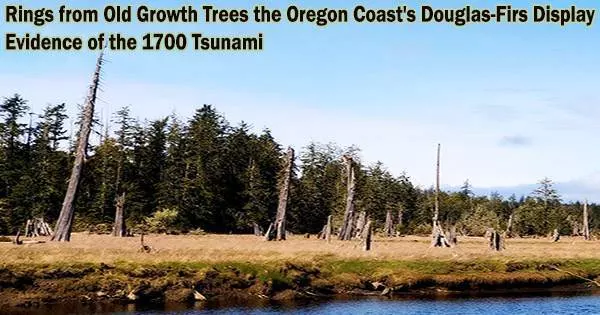Archived core samples from an old growth stand Following the 9.0 earthquake and related tsunami that hit the Pacific Northwest in 1700, Douglas-fir trees in the South Beach neighborhood just south of Newport displayed diminished growth.
The last significant earthquake to strike the Cascadia Subduction Zone, the January 1700 quake, was supported by physical evidence from the Douglas-fir tree rings, according to modeling, according to Robert Dziak, a scientist with the National Oceanic and Atmospheric Administration Pacific Marine Environmental Laboratory who works out of the Hatfield Marine Science Center.
“The tsunami appears to be the event that most affected the trees’ growth that year,” said Dziak, whose work includes ocean acoustic studies, signal analysis, and tsunami modeling. He also holds a courtesy appointment in Oregon State University’s College of Earth, Ocean, and Atmospheric Sciences. “Getting these little bits of the picture helps us understand what we might expect when the next ‘big one’ hits.”
Recent research on the subject was published in the journal Natural Hazards and Earth System Sciences.
The research was first conceived more than ten years ago by Dziak, who was aware of earlier studies that had shown evidence of the 1700 earthquake in trees in Washington. He reasoned that it could be worthwhile to investigate whether a similar pattern existed in Oregon.
Finding a stand of old-growth Douglas-firs in the tsunami flood zone was the first difficult task. Before finding the stand in Mike Miller Park in South Beach, which is 1.2 kilometers east of the current ocean shoreline and two kilometers south of Yaquina Bay, the researchers searched a number of locations.
The tsunami appears to be the event that most affected the trees’ growth that year. Getting these little bits of the picture helps us understand what we might expect when the next ‘big one’ hits.
Robert Dziak
“We’re not sure why this tree stand wasn’t logged over the years, but we’re very fortunate to have a site so close to the coastline that has survived,” said coauthor Bryan Black of the Laboratory of Tree-Ring Research at the University of Arizona, Tucson.
In the 1700 tsunami event, the region may have been submerged by up to 10 meters of water, according to a new and updated tsunami model that the researchers ran as part of the study, said Dziak.
After locating the old-growth stand, the researchers took core samples from roughly 38 trees using a method that permits them to examine the tree rings without endangering the health of the trees as a whole. The majority of the trees dated to around 1670, with one dating to 1650, Dziak said.
The development rates in the rings were examined, and they were contrasted with those of other old-grown Douglas-fir trees located in locations beyond the tsunami inundation zone. They discovered that in 1700, the growth rate of the trees in the tsunami inundation zone was noticeably slower.
Given that the trees are quite far from the shoreline, researchers are still trying to determine why the tsunami might have had an impact on their growth. They speculate that it might be caused by both the seawater flooding and the earthquake’s shaking of the ground.
“The salty seawater from a tsunami typically drains pretty quickly, but there is a pond area in Mike Miller Park where the seawater likely settled and remained for a longer period of time,” Dziak said.
The next stage, according to Black, will be for the researchers to perform an isotopic analysis on the 1700s-era wood.
“We will look for signatures consistent with those found in trees that were inundated by the 2011 Tohoku tsunami in Japan,” he said. “If successful, we could develop a powerful new technique to map prehistoric tsunami run-ups along the Pacific Northwest coast.”
Additional coauthors of the study are Yong Wei of the University of Washington Cooperative Institute for Climate, Ocean and Ecosystem Studies with NOAA/PMEL in Seattle; and Susan Merle of the Cooperative Institute for Marine Resource Studies at Hatfield Marine Science Center.





